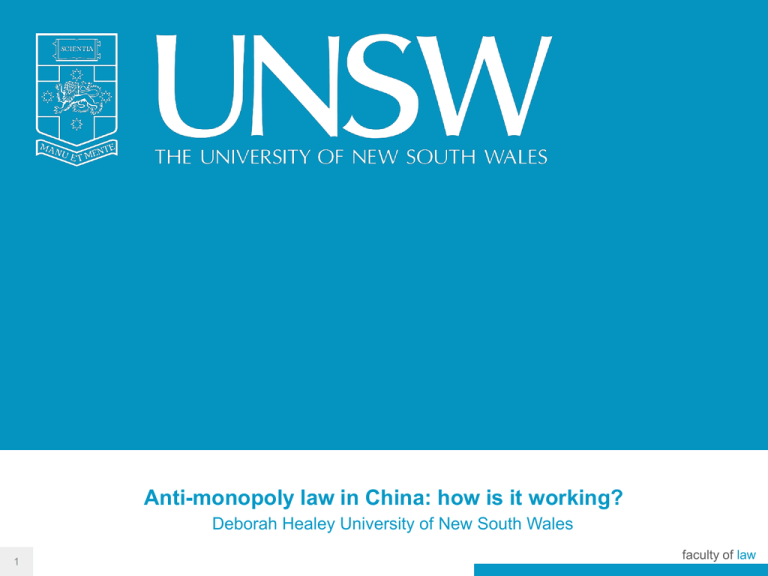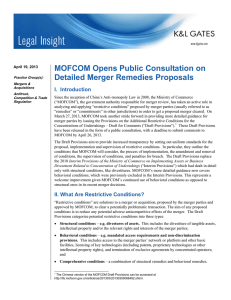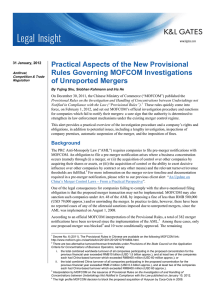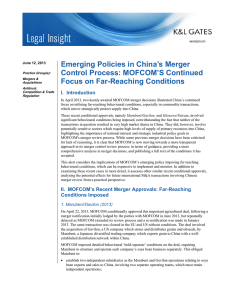Anti-monopoly law in China: how is it working? faculty of law
advertisement

Anti-monopoly law in China: how is it working? Deborah Healey University of New South Wales 1 faculty of law This presentation • Anti-Monopoly Law China 2007 operative 2008 (AML) • Issues arising from political economy • Brief comments on content of AML • General observations on problems • Focus on merger determinations to date/ Australia as counterpoint - Approach of regulators : MOFCOM (China)/ ACCC Australia - Procedures and guidelines - Market definition -Competition analysis -Conditions • Trends 2 faculty of law Elements of political economy • Move to market economy from1978 when there was price setting and competition was an unknown concept • Has picked up pace since 1998 when reform of SOEs intensified • Accesssion to WTO in 2001 • Legal “ explosion ” but unsatisfactory enforcement; judges untrained • Vague legal language and no real concept of competition makes it difficult for judges • Poor systems of administrative review • High levels of administrative monopoly • Perceptions about unfair competition and excessive competition -industrial self discipline • Fears about foreign incursions into market 3 faculty of law The AML prohibitions • Abuse of dominance - market share thresholds, rebuttable presumption • Monopoly agreements - many specifically identified and prohibited unless falling within exemptions -exemptions broad • Mergers and acquisitions -compulsory notification over threshold turnover • Administrative monopoly • Recognition of the importance of competition as a market regulator 4 faculty of law Potential problems with AML • Objects are varied and some are at odds with competition itself - “promoting the healthy development of the socialist market economy” - “ well-ordered market system” - - role of industry associations- also talks of protecting orderly competition • Overlap with existing laws 5 faculty of law Potential problems with AML • Large number of potential carve-outs – – – – Sector specific laws and regulations “Life line” industries (art 7) Farmers By State Council and law • Broad discretions • Enforcement- 3 bodies : MOFCOM, NDRC, SAIC • TO DATE: Few cases under most provisions and most by individuals unsuccessful 6 faculty of law Merger law: key questions • • • • • • • • 7 How is market defined? Who does the provision apply to? What is the test? What are you looking to prevent? Is there compulsory notification? What are the thresholds for notification? How is the test applied? Is there guidance? What is the process? Timing? Confidentiality? Procedural fairness and transparency? What are the implications of a refusal by the authority? Processes for negotiating an outcome? How formalised? faculty of law Caution in comparisons: vastly differing political economies Australia • purely economic objective: “enhancing welfare of Australians through promotion of competition, fair trading and provision for consumer protection” CCA s2 • Robust law, long history of merger analysis China • Similarities with Australia but additional objectives: -promotion of socialist market economy (AML Art 1) -voluntary concentration improving market competition (AML Art 5) -role of SOEs in economy/industry policy • Developments but notruly detailed determinations by MOFCOM faculty of law China AML Art 28 • Prohibits concentrations which will or may eliminate or restrict competition • Merger factors • Will allow if parties prove that advantages exceed disadvantages • Additional national security review for foreign parties • Notify MOFCOM over threshold turnover levels • Phase I, Phase II review faculty of law Australia • S50 CCA • Substantial lessening of competition test • Merger factors • Informal clearance, formal clearance, authorisation • Self assessment of risk- no obligation to notify regulator • Regulator may take court action to prevent a merger 10 faculty of law Notifications China • 384 mergers from 2008 to the end of 2011 - many mergers are not notified hence new guideline on failure to notify Australia • 345 mergers in 2010-2011 financial year without compulsory notification China • Only obliged to issue written reasons if a merger is declined or conditions are imposed • Very small number of decisions from which we can learn • No learning, for example, on issue of public interest, or when the advantages of a merger might outweigh the disadvantages 11 faculty of law Merger analysis How does Australia approach the analysis? 12 • • • • • Market definition (SSNIP test) Market shares/concentration (HHI, CRn) Competition effects in the absence of countervailing power Unilateral effects Co-ordinated effects • • • • Buyer power Entry( timeliness, likelihood, sufficiency) Efficiencies Failing firm test faculty of law What is a market? • Traditional view is that it is an area of close competition which assists in the determination of market power in a particular set of circumstances • Other countries: product, geography, function and time • Australia: “field of actual and potential transactions” • AML “ product scope or territory where undertakings compete” with little more guidance (Art 12) • Guidelines on Definition of Relevant Market - stress importance of methodical and appropriate definition -use “hypothetical monopolist test”/ HHI/SSNIP test 13 faculty of law Market: determinations of MOFCOM InBev/ Anheuser Busch -“beer market in China” without additional comment Pfizer/Wyeth, Panasonic/Sanyo,Novartis/Alcon -more detailed analysis but still limited information • Undue emphasis on mere overlapping markets? Coca Cola/ Huiyuan Juice Group -Carbonated beverages -”Chinese fruit juice industry” -”fruit juice beverage market” - No real discussion of the relationship between the two markets 14 faculty of law Market :determinations of MOFCOM General Motors/Delph -Market for passenger cars and commercial vehicle -10 auto parts markets “Chinese domestic market” but competitive impacts considered in the “global and Chines auto parts market” Uralkali and Silvinit -Potash (internationally traded commodity) -market for imports or seaborne trading of all grades of potassium chloride to China Savio and Alpha V -Electronic yarn clearers for automatic winders -Same market proportions of the subsidiaries for both the world and China 15 faculty of law Market: determinations of MOFCOM GE and Shenhua Coal -Joint venture -Market for licensing coal gasification techniques in China Samsung Electronics and Seagate -Worldwide hard disk drive (HDD) market -Submarkets for different end uses such as servers, desktop computers, laptops and consumer electronics but no discussion of functional level -Western Digital Corporation and Viviti Technologies - similar market definition Henkel Hong Kong/Tiande Chemical -three upstream, midstream and downstream chemicals in the industrial production chain were separate product markets 16 faculty of law Conclusions on MOFCOM market definition • National market is the most common finding • MOFCOM routinely consults thoroughly with interested parties, and third party experts and parties have the opportunity to address specific MOFCOM concerns prior to final determination BUT • Undue emphasis on areas of overlap • Very broad geographic markets always • Views of 3rd parties and unsuccessful arguments not documented • Despite apparent growing sophistication of decision making, reasons are still scant and comprise conclusions rather than reasoning 17 faculty of law Conclusions on MOFCOM market definition • Latest decisions are more sophisticated • More considered comments • Still some emphasis on areas of overlap between the parties BUT • Reasons are slightly fuller and contain more detail although the emphasis is still on the conclusions of MOFCOM, and not on how they got there 18 faculty of law Market definition in Australia • Quantitative and qualitative issues considered • Markets may be small in the context of the national economy but substantial in the context of a State or regional economy Product market • Coca Cola/Berri Juice Geographic market • Australian Meat Holdings • AGL Functional market • QIW Retailers v Davids • Re QIW • ACCC v Metcash faculty of law The law, merger guidelines and analysis: China Article 27 prohibits concentrations which eliminate or restrict competition, but if advantages exceed disadvantages will be allowed Merger factors: •Market shares and market power •Market concentration •Effect of concentration on market access and technological progress •Effect on consumers and other businesses •Effect on national economic development •Other factors that affect market competition at MOFCOM discretion 20 faculty of law Various guidelines Including: • Provisional Rules on Assessment of Competitive Effects of Concentration of Business Operators 2 September 2011 (operative 5 September 2011) (“Merger Guidelines”) • Draft Interim Measures on the Investigations and Handling of Concentrations Not Notified in Accordance with Applicable Laws 13 June 2011 Foreshadowed at recent BRICS conference for next 12 months: • Rules on imposing restrictive conditions on concentrations of operators • Rules on investigation and handling of violation of notification obligations • Rules on mergers below thresholds faculty of law General comments on MOFCOM Competitive Effects Guidelines • Recognise both unilateral and co-ordinated effects but little discussion on impacts of these • Market share an important starting point but other factors important: current state of competition in market; whether parties close competitors; excess capacity; countervailing market power; financial and technological advantages of merging parties; • HHI but no thresholds for safety, so no real guidance on possible outcomes • Focus on heightened barriers to entry • Merger may increase economic efficiency or have negative effects • Concentration may increase competitive pressure in markets • Healthy development of industry and national economic development (interplay between competition policy and industrial policy) • Risk of insolvency without indication of how it will be treated faculty of law Analysis in practice InBev/ Anheuser Busch - very brief -no real discussion of shareholdings and effect in determination except to say that the concentration was very big Coca Cola/ Huiyuan Juice Group -rejected -reliance on Australian determination -denial that industry policy played a part 23 faculty of law Analysis in practice Mitsubishi Lucite -market share of companies in MMA 64% -dominant position and forced divestitures including right of purchaser to purchase MMA products for 5 years -Structural conditions: Mitsubishi not to acquire or establish additional plants for 5 years, nor acquire producers of MMA,PMMA or cast sheets in China or establish plants for these products General Motors/Delphi -vertical merger -Delphi a major supplier to many car mfrs/confidential information and might make switching difficult -Behavioural conditions: after the concentration Delphi must continue to supply domestic customers without price discrimination or unreasonable conditions 24 faculty of law Analysis in practice Pfizer/Wyeth -more complex consideration “HHI”, although always dependent on the correct market definition -market seems to just include the areas of overlap on many occasions Panasonic/ Sanyo - 3 separate battery markets , -importance of brands - divestiture included part of jv share and renaming the jv without use of “Panasonic” Novartis/Alcon -compounds market parties had large market share globally although only 1% in China- query whether this lessens competition in China -care products- links between the parties made it more problematic 25 faculty of law Analysis in practice Uralkali/Silvinit -considers unilateral effect, co- ordinated conduct, market position, position of competitors, barriers to entry, impact on customers and suppliers Savio /Alpha V - Alpha V would have capacity to influence the operations of Uster (52.3%) and Loepke (47.7%), the only two manufacturers of the machinery worldwide - Finding that there was a likelihood of co-ordinated conduct which would restrict or eliminate any competition faculty of law Analysis in practice GE/ Shenhua Coal -Water coal slurry gasification technology licensing jv -Process transforms coal from its hard form to coal water slurry, which is processed to produce gas-only 3 in the market -Shenhua was the largest producer of appropriate coal and vertically integrated with transport by road, rail and ship -MOFCOM found that the technology, patents, and economies of scale meant barriers to entry were very high -Behavioural conditions were imposed to prevent the tying of coal supply to technology and vice versa 27 faculty of law Analysis in practice • Seagate/ Samsung • - behavioural conditions imposed to keep businesses separate for a year, expand the Samsung business and not to force exclusivity arrangements on customers 28 faculty of law Conclusions on determinations • There is generally no discussion in the determinations of how the merger factors are applied even though the concepts are sometimes mentioned • There is no discussion of rejected arguments or other points considered, either of third parties or MOFCOM itself • There appears to be an undue focus on market share and areas of overlap between the parties particularly in earlier determinations • Industry policy may play a part despite denials but this is not well explained • More recent determinations show a significant increase in sophistication with some reasoning now demonstrated 29 faculty of law Australia Merger factors in s50(3) of the CCA explained in Australian Merger Guidelines -70 pages of information on how the ACCC will consider the factors contained in s50(3) - test of whether there is or is likely to be a substantial lessening of competition is “future with or without” the merger 30 faculty of law Australia: Merger factors • • • • • • • Import competition s50(3)(a) Barriers to entry s50(3)(b) Concentration s50(3)(c) Countervailing market power s50(3)(d) Ability to increase prices or profit margins s50(3)(e) Availability of substitutes s50(3)(f) Dynamic characteristics innovation and product differentiation s50(3)(g) • Removal of an effective and vigorous competitor s50(3)(h) • Vertical mergers and vertical integration s50(3)(i) Other issues : Failing firms faculty of law Remedies imposed by regulators Australia: court enforceable undertakings • Coca Cola / Berri – not acceptable • Toll/Patrick- detailed and both structural and behavioural China: relationship between harm and conditions often vexed issue • Potash case- structural and behavioural -open-ended -maintenance of current sales practices -continue full range of supply insufficient quantities -maintain existing negotiation practices DO THESE CONDITIONS INHIBIT MARKET FLEXIBILITY? More recent determinations are more easily understood and better justified faculty of law National Security Review China •AML Art 30 •Measures on Implementation of Security Review of Mergers and Acquisitions of Domestic Enterprises by Foreign Investors (Measures) 25 August 2011 •Wide view of “national security” including economic security Australia •Foreign Investment and Takeovers Act 1975 •Foreign Investment Policy -undertaken in parallel but outside competition law -rarely prevented but new rules on SOEs faculty of law Trends • China has made significant progress with AML • Little successful general enforcement • Only one administrative monopoly case reported • MOFCOM more active • MOFCOM approach developing significantly but more information is still needed such as: -more detailed analysis of market -details of submissions of competitors and third parties -rejected arguments and theories -more detailed conclusions on anti-competitive impact -reasons why imposed conditions would alleviate harm • Establish a body of experience for education and understanding faculty of law








